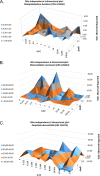Combination of Amphotericin B and Flucytosine against Neurotropic Species of Melanized Fungi Causing Primary Cerebral Phaeohyphomycosis
- PMID: 26833164
- PMCID: PMC4808187
- DOI: 10.1128/AAC.02526-15
Combination of Amphotericin B and Flucytosine against Neurotropic Species of Melanized Fungi Causing Primary Cerebral Phaeohyphomycosis
Abstract
Primary central nervous system phaeohyphomycosis is a fatal fungal infection due mainly to the neurotropic melanized fungiCladophialophora bantiana,Rhinocladiella mackenziei, andExophiala dermatitidis.Despite the combination of surgery with antifungal treatment, the prognosis continues to be poor, with mortality rates ranging from 50 to 70%. Therefore, a search for a more-appropriate therapeutic approach is urgently needed. Ourin vitrostudies showed that with the combination of amphotericin B and flucytosine against these species, the median fractional inhibitory concentration (FIC) indices for strains ranged from 0.25 to 0.38, indicating synergy. By use of Bliss independence analysis, a significant degree of synergy was confirmed for all strains, with the sum ΔE ranging from 90.2 to 698.61%. No antagonism was observed. These results indicate that amphotericin B, in combination with flucytosine, may have a role in the treatment of primary cerebral infections caused by melanized fungi belonging to the orderChaetothyriales Furtherin vivostudies and clinical investigations to elucidate and confirm these observations are warranted.
Copyright © 2016, American Society for Microbiology. All Rights Reserved.
Figures

Similar articles
-
In vitro evaluation of antifungal combinations against neurotropic dematiaceous fungi associated with primary cerebral phaeohyphomycosis.Microbiol Spectr. 2024 Aug 6;12(8):e0078124. doi: 10.1128/spectrum.00781-24. Epub 2024 Jun 26. Microbiol Spectr. 2024. PMID: 38920376 Free PMC article.
-
In vitro activity of amphotericin B and itraconazole in combination with flucytosine, sulfadiazine and quinolones against Exophiala spinifera.J Antimicrob Chemother. 2003 May;51(5):1297-300. doi: 10.1093/jac/dkg218. Epub 2003 Apr 14. J Antimicrob Chemother. 2003. PMID: 12697648
-
Combination of amphotericin B with flucytosine is active in vitro against flucytosine-resistant isolates of Cryptococcus neoformans.Antimicrob Agents Chemother. 2007 Jan;51(1):383-5. doi: 10.1128/AAC.00446-06. Epub 2006 Oct 16. Antimicrob Agents Chemother. 2007. PMID: 17043122 Free PMC article.
-
Cerebral phaeohyphomycosis due to Rhinocladiella mackenziei in Persian Gulf region: A case and review.Mycoses. 2018 Apr;61(4):261-265. doi: 10.1111/myc.12734. Epub 2018 Jan 3. Mycoses. 2018. PMID: 29205524 Review.
-
Antifungal agents. Part I. Amphotericin B preparations and flucytosine.Mayo Clin Proc. 1998 Dec;73(12):1205-25. doi: 10.4065/73.12.1205. Mayo Clin Proc. 1998. PMID: 9868423 Review.
Cited by
-
Antifungal Susceptibility of Melanized Fungi Isolated from CARD9 Deficient Patients: Implications for Treatment of Refractory Infections.Mycopathologia. 2025 Feb 28;190(2):29. doi: 10.1007/s11046-025-00936-8. Mycopathologia. 2025. PMID: 40021530
-
1,3-Thiazine, 1,2,3,4-Dithiadiazole, and Thiohydrazide Derivatives Affect Lipid Bilayer Properties and Ion-Permeable Pores Induced by Antifungals.Front Cell Dev Biol. 2020 Jun 30;8:535. doi: 10.3389/fcell.2020.00535. eCollection 2020. Front Cell Dev Biol. 2020. PMID: 32695784 Free PMC article.
-
Exophiala dermatitidis.World J Clin Cases. 2021 Sep 26;9(27):7963-7972. doi: 10.12998/wjcc.v9.i27.7963. World J Clin Cases. 2021. PMID: 34621853 Free PMC article.
-
The convoluted process of diagnosing pulmonary mycosis caused by Exophiala dermatitidis: a case report.BMC Infect Dis. 2022 May 4;22(1):433. doi: 10.1186/s12879-022-07399-y. BMC Infect Dis. 2022. PMID: 35509001 Free PMC article.
-
Cerebral Phaeohyphomycosis Caused by Exophiala dermatitidis in a Chinese CARD9-Deficient Patient: A Case Report and Literature Review.Front Neurol. 2019 Sep 3;10:938. doi: 10.3389/fneur.2019.00938. eCollection 2019. Front Neurol. 2019. PMID: 31551907 Free PMC article.
References
-
- De Hoog GS, Queiroz-Telles F, Haase G, Fernandez-Zeppenfeldt G, Attili Angelis D, Gerrits Van Den Ende AH, Matos T, Peltroche-Llacsahuanga H, Pizzirani-Kleiner AA, Rainer J, Richard-Yegres N, Vicente V, Yegres F. 2000. Black fungi: clinical and pathogenic approaches. Med Mycol 38(Suppl 1):S243–S250. - PubMed
-
- Horre R, De Hoog GS. 1999. Primary cerebral infections by melanized fungi: a review. Stud Mycol 43:176–193.
Publication types
MeSH terms
Substances
LinkOut - more resources
Full Text Sources
Other Literature Sources

